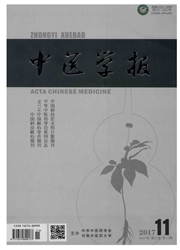

 中文摘要:
中文摘要:
察"肌肤"在中医外科的诊治中必不可少。辨证施治是中医的特色,在中医外科的诊疗中同样至关重要,历代中医古籍中通过辨肿痛、辨脓、辨痒等体表肌肤情况,来判断中医外科疾病的特点,正确指导施治。尤其在明清时期中医外科三大学术流派"正宗派""全生派""心得派"中,《外科正宗》《外科证治全生集》《疡科心得集》3本书对中医外科疾病的病名、病因病机及辨证施治进行了更详细的论述,把体表肌肤的情况和辨证施治结合起来,推动了中医外科的发展。
 英文摘要:
英文摘要:
Chinese medicine syndrome differentiation is the basic principle in understanding and treatment of disease. According to TCM surgical literature,the characteristics of"skin"are closely related to the disease treatment and surgery. Therefore,it is significant to grasp the essential characteristics of the "skin"in TCM treatment of surgical diseases. For example,the observation and examination of"pain","pus"or"itching"phenomena of the skin can help with the syndrome differentiation and the treatment of the diseases. In TCM history,three important classics written in Ming or Qing Dynasty,namely,Wai Ke Zheng Zong( Orthodox Manual of External Medicine),Wai Ke Zheng Zhi Quan Sheng Ji( Life-Saving Manual of Diagnosis and Treatment of External Diseases) and Yang Ke Xin De Ji( Medical Experience Gained in Treating External Diseas),offer us many valuable information in this field by illustrating the names,the etiology and the pathogenesis of the diseases in TCM. In these classics works,the relationship between the conditions of the"skin"and the syndrome differentiation are also specifically discussed,which makes great contribution to the development of TCM surgery.
 同期刊论文项目
同期刊论文项目
 同项目期刊论文
同项目期刊论文
 期刊信息
期刊信息
